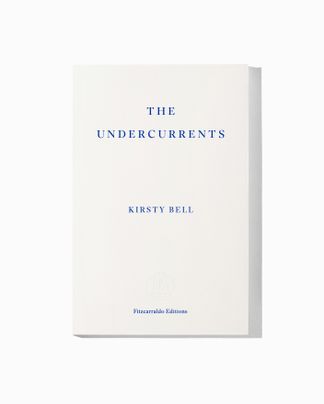In a world that demands faith in progress and growth, Limbo is a companion for the stuck, the isolated, delayed, stranded and those in the dark. Fusing memoir with a meditation on creative block and a cultural history of limbo, Dan Fox considers the role that fallow periods and states of inbetween play in art and life. Limbo is an essay about getting by when you can’t get along, employing a cast of artists, ghosts and sailors – including the author’s older brother who, in 1985, left England for good to sail the world – to reflect on the creative, emotional and political consequences of being stuck, and its opposites. From the Headington Shark to radical behavioural experiments, from life aboard a container ship to Sun Ra’s cosmology, Limbo argues that there can be no growth without stagnancy, no movement without inactivity, and no progress without refusal.

Limbo
French paperback with flaps, 120 pages | Audiobook read by Dan Fox
Published 1 October 2018 (UK) | 30 April 2019 (US)
Limbo
One August morning in 1986, a 25-foot shark became stuck in the attic of a terraced house in Headington, a suburb of Oxford. The fish appeared to have plunged head-first from the clouds, although there had been no reports of a freak deluge of cats, dogs and chondrichthyes the previous night. Like all sharks, it snuck up without asking first. Jammed inside the slate-tiled roof, tail cursing the sky, this new addition to Oxford’s dreaming spires divided local residents. ‘Ooh it makes me mad, I think it’s a damn monstrosity,’ said one neighbour. ‘I mean, sharks don’t fly, do they?’ She was right. No sharknado witnesses stepped forward.
Oxford City Council tried to have the predator removed. First they cited public safety concerns, then changed tack and accused the shark of violating planning regulations. The shark refused to budge. A lengthy battle ensued. The fate of the fish was eventually placed in the hands of central government, and in 1992 the Department of the Environment, encouraged surprisingly by Conservative minister Michael Heseltine, ruled that it could stay. ‘The Council is understandably concerned about precedent here,’ wrote government inspector Peter Macdonald. ‘The first concern is simple: proliferation with sharks (and Heaven knows what else) crashing through roofs all over the City. This fear is exaggerated. In the five years since the shark was erected, no other examples have occurred. Only very recently has there been a proposal for twin baby sharks in the Iffley Road. But any system of control must make some small place for the dynamic, the unexpected, the downright quirky. I therefore recommend that the Headington Shark be allowed to remain.’
The monster – genus Untitled 1986 – had been built from fibreglass by local artist John Buckley. He installedhis sculpture under cover of night to mark forty-one years since the detonation of the ‘Fat Man’ atomic bomb over Nagasaki on 9 August 1945. For Buckley it was an oblique gesture of outrage at the existential threat of nuclear annihilation. Untitled 1986 arrived the year Gorbachev first mentioned Glasnost. This was the era of Chernobyl, the Campaign for Nuclear Disarmament and the Greenham Common Women’s Peace Camp. That spring, USAF Ravens dispatched from nearby Upper Heyford airbase had been seen in the skies over Oxfordshire on their way to bomb Tripoli. ‘One question only comes to the lips: Why?’ asked a puzzled BBC reporter at the scene. Bill Heine, local radio personality and the owner of the house, explained: ‘The shark was to express someone feeling totally impotent and ripping a hole in their roof out of a sense of impotence and anger and desperation.’ Heine, a US expat, had a reputation for rubbing Oxford residents the wrong way. As proprietor of two local independent cinemas he had previous form, commissioning large sculptures for his theatre façades: a pair of high-kicking cancan dancer legs at Not the Moulin Rouge, a few hundred metres from the shark, and, unfortunately, Al Jolson’s minstrel hands over the entrance to the Penultimate Picture Palace in nearby Cowley. For one middle-aged man interviewed by the BBC about Untitled 1986, Heine could go sling his hook: ‘I grew up in this town, and in my view the majority of people in this town are sick and tired of the publicity stunts of this crazy Canadian [sic] nutcase and if any of the Great British Public wants him on a free transfer they can have him today.’
I grew up in the nearby village of Wheatley, a few miles east of Oxford. The number 280 bus drove through Headington on its route to and from town,passing the shark in both directions. The shark marked distance. It signalled when to think about getting up to press the request stop bell on the way into the city centre, and on Friday night’s last bus home measured how much longer you’d have to spend hoping the drunks wouldn’t notice you before escaping at Wheatley. I turned ten when Buckley’s artwork appeared. I found it funny, and believed that more people should have giant fish installed in their roofs. Into my teens, I would pass this small-town Jaws so many times that it became unremarkable, practically invisible. By my early twenties I was working professionally as an art critic. Snotty and of firmly held opinions, on the rare occasions I registered the shark I dismissed it as a one-liner, sculptural slapstick. I thought no more of it for years.
Visiting Mum and Dad early in 2018, I took the 280 from Wheatley into Oxford. Entering Headington, a sudden impulse told me to get off and take a closer look at the shark, then walk the remaining two miles into the city. It was as though I were responding to a mysterious signal generated by the sculpture. Like the superintelligent monoliths in Stanley Kubrick’s 2001: A Space Odyssey – if they had resolved that the most persuasive technique for shepherding humanity to the next evolutionary level was to take to the suburbs in the form of surrealist fish.
Trying my best to act casual and avoid looking like a creep, I stood outside the house staring at Buckley’s work for some time. This Headington skyscraper was about to mark its thirty-second year wedged between the chimney pots, and I was fast approaching forty-two. A decade spent living in New York had defamiliarized the sight of it. Buckley’s symbol of frustration became visible again. I thought of another untitled sculpture I had seen, by an artist who was curious why images andobjects lose our attention the longer we spend with them. In 2007, Simon Martin made a bronze figurine that he only considered ‘activated’ if a fresh organic lemon was placed next to it. If there was no lemon, or if the citrus had rotted, Martin ruled the artwork incomplete. The act of replacing the fruit every week or two was analogous to watering the plants, a reminder not to let the familiar turn invisible, neglected. In 2018, the spectre of nuclear conflict, tensions with Russia, a resurgent Right and women leading protests in the streets were back in the news. Fresh lemons for Buckley’s sculpture.
What an odd sight it must have been for people seeing it in 1986 – five years before Damien Hirst turned a taxidermied shark into an artwork iconic of the 1990s, decades before pop-comical works like this became more common, the kind of spectacle you might find sitting on the Fourth Plinth in Trafalgar Square, London, or helping a New York plaza art-wash its private ownership. I was reminded of a question a student once asked me: ‘When does a work of art happen?’ Firstly, in the moment of its production – in the mind, then studio, then display, when its constituent parts lock into context. Secondly, when the art meets its audience and gaps, productive or otherwise, between the creative intent and its reception emerge. After that, a work of art might continue to resonate, or it can stop happening, instead drifting into aesthetic and intellectual obsolescence for years, left to gather dust on the shelf until the times change and it slips back into fashion or serious conversation again. (Stopped clocks twice a day, and all that.) If the artwork is lucky, something catches the eye of a younger generation, who blow off the cobwebs and in doing so find something altogether new to appreciate in it.
I wanted to understand why my focus on Buckley’s monster had crispened. No claims for it as Great Art came to mind. It didn’t need my advocacy. The power of Untitled 1986 was in its obduracy. A cosmic joke about political agency and death that had survived enough news cycles to start being perversely funny again as history repeated itself.
The signals I was responding to were more personal.
(…)
The White Review Books of the Year 2018 | The Irish Times Books of 2018
‘Dan Fox has produced a fascinating work of understated excellence, particularly given his starting point. Eloquent in its consideration of the subjects it focuses on and elegant in the brevity and precision of its chapters, Limbo gets to the heart of the matter and gives you something to think about.’
— Pendora Magazine
‘Open-spirited and beautifully written.’
— Kate Wakeling, TLS
‘Limbo mixes the historical, the conceptual and the anecdotal in a very elegant way, and it is a testament to Fox’s ability as a writer that he can make, in what is a relatively short book, such disparate ideas and stories fall into place in a narrative that feels really clear and organised.… While obviously an astute cultural theorist who can draw on a truly diverse range of sources, it is the personal element of Limbo brings out the storyteller in Fox.… it is in writing about his family relationships, and the transition through adolescence into adulthood, which brings the true depth to the book.’
— The London Magazine
‘Every page of this small book surprises you and makes you think.’
— Dan Kois, Slate
‘I felt understood reading Dan Fox’s Limbo, a book-length essay for the unsteady and unsure among us.’
— Nicole Flattery, author of Show Them a Good Time
Praise for Pretentiousness: Why it Matters
‘Dan Fox makes a very good case for a re-evaluation of the word “pretentious”. The desire to be more than we are shouldn’t be belittled. Meticulously researched, persuasively argued – where would we be as a culture if no-one was prepared to risk coming across as pretentious? Absolument nowhere, darling – that’s where.’
— Jarvis Cocker
‘Pretentiousness: Why It Matters is more than a smartly counterintuitive encomium: it’s a lucid and impassioned defence of thinking, creating and, ultimately, living in a world increasingly dominated by the massed forces of social and intellectual conservatism. I totally loved the book.’
— Tom McCarthy, author of Satin Island
‘Dan Fox’s book celebrates the art in artifice, the let’s pretend in pretentiousness, arriving at an eloquent, important understanding of how culture has always provided an escape from the dreariness of routine work and productive life. Exhaustively researched and passionately written, recognizing those who audaciously “pretend” to beauty beyond their present means, Pretentiousness is a deeply optimistic and affirming book.’
— Chris Kraus, author of I Love Dick
‘In tackling so directly a term – “pretentiousness” – that has been thrown around too lightly for too long, Dan Fox has opened a fascinating, illuminating and barely glimpsed before perspective onto both culture and criticism. With clarity and persuasive argument he proves from an etymological basis that pretentiousness can be both good and bad – necessary even to cultural and artistic good health. This insightful book should be read like a contemporary reprise of an eighteenth-century essay on critical manners, for it shares with such texts the winning combination of wit, good sense and intellectual rigour.’
— Michael Bracewell, author of England is Mine
‘Epoch-making, epic, historic, unforgettable, triumphant, age-old, inevitable, inexorable, and veritable. Pretentiousness will never look the same.’
— Elif Batuman, author of The Possessed
Dan Fox is a writer, musician, and filmmaker. He is based in New York.




